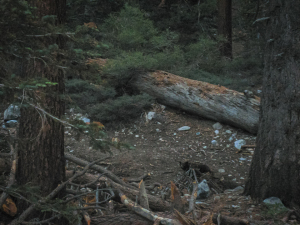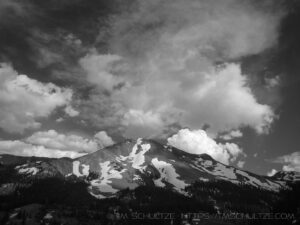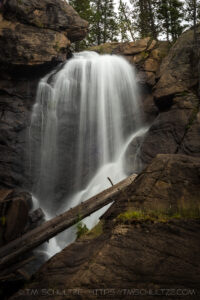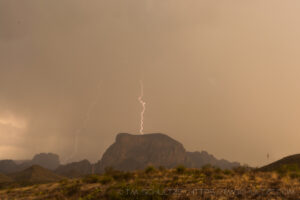Right now, I am finishing up Arctic Dreams by Barry Lopez, an excellent book recommended by friend Joe. One of the chapters dealt with incredible detail on polar bears. It reminded me of the first time I read Moby Dick, which had an entire chapter on how Melville would classify whales.
Melville’s chapter sucked. Yet, Lopez weaves narrative with incredible detail on a strange and fascinating animal. Writing has come a long way since the 19th century.
So, I got to thinking about bears.
Let’s Start With Some Bear Bags

My best story about bears took place in 2008. We were climbing Mt. San Gorgonio as part of several peaks to prepare for a backpack up Mt. Whitney. Many overnight backpackers stay at Halfway Camp (which isn’t halfway, I might add) so they can drop their heavy gear, allowing them to finish the peak with just day hiking essentials.
After climbing the peak on Saturday, I woke up early on Sunday morning to quite the surprise. A black bear was dutifully watching my bear bag with intense focus, sitting directly under it and looking above.
Bear bags were something I had been doing since my earliest days of Scouting, without much thought. At Philmont (BSA’s National High Adventure Base, at least for the moment), they often added tall telephone poles with long guy-wires to hang our gear from. There, you had to tie it off twice, in case rodents went out on the lines. With my friends in Socal, just a single line was fine.
Hanging was rather simple, as long as you chose a proper limb. Too small a pine limb and it would snap. You also needed it to be high enough to be beyond a bear’s reach. Time and again, I would see people hang their bear bag 5 feet off the ground and sigh at the obvious. Not much of a challenge for ursus americanus.
To get it high enough, you simply needed to tie off a rock, giving you something to throw over the limb. Then, you pulled the line taut and tied it around the tree.
On this July morning, I was pretty happy to see I placed it correctly the previous evening. The bear, silent sentinel he was, simply sat under the bag. Being that Black Bears are predominantly nocturnal, I wondered how long he sat under there, patient but unable to boost his Summer caloric needs in preparation for what passes for a cold season in Southern California. The climate in the Transverse Ranges has clearly changed since my childhood. I wonder if the Black bears even needed to hibernate in these parts anymore.
Oh No, There’s A Bear Out There
For about 10 minutes, I sat on a log and watched the bear. He made no movement. He was less than 50 feet from me. He was indifferent to my presence. He was most concerned with the goods in the bag. I enjoyed hanging out with him, from a distance.
After some reflection, the other campers began to stir. A Scout Troop from Corona next to us was alarmed. One of the kids walked over and I motioned for them to stop. A younger kid said, “What do we do when there is a bear?” I said, “You just leave it alone.” No more words were exchanged.
Within another 10 minutes, the humdrum of morning clatter from the Halfway Camp homo sapiens became a steady din. Our Black Bear wasn’t a big fan, got restless, and he simply left. I didn’t have an SLR at the time, so I took some bad point-and-shoot photos. The bear didn’t care. He looked very healthy, already plump from the need to prepare for Winter, and what was certainly the careless scraps left behind by lazy humans. He headed over the main Vivian Creek Trail, ambled directly up the hill with a grace and dexterity belying his build, and he was gone.
The Black Bear doesn’t belong here, but his presence is through no fault of his own. The only native bear to Southern California was the Grizzly Bear. They lived stably among the Native American Nations of Southern California for thousands of years. As the scramble for minerals and timber brought immense environmental pressure to the mountains, that stability was gone. The Grizzly population was hunted down for meat, for sport, and for a false sense of its role as a predator.
Men were killed by Grizzly Bears, although often it came when they were hunting the beasts. William Holcomb, known as Grizzly Bill and the namesake of Holcomb Valley, was known to have killed nearly all of the population in Bear Valley.
When you hear somebody mention Big Bear, they are talking about the community named after the Grizzly. By the time they got around to naming a community after the majestic animals, there weren’t any left. They might as well have named the town Big Mammoth or Big Saber-Toothed Cat.
We Extirpate Mountains Too
One interesting story is reading that one of the last Inland Empire Grizzly Bears to be shot was on Slover Mountain. Isaac Slover himself was killed by a Grizzly Bear in Cajon Pass, probably failing to kill it himself. Slover Mountain used to be a major landmark South of US Highway 99, at 1,184 feet above the valley floor. Its part of a larger network of mountains (or hills) that the Santa Ana River winds through along the San Bernardino-Riverside County line.
Slover Mountain would then be mined for marble and limestone, and was the major cement mine for Portland Cement. They had a huge US flag that flew on top, and as a kid, I thought it was neat seeing them lower the mountain. I no longer feel that way.
They lowered Slover Mountain to the point of hitting the San Bernardino Valley water table. Slover Mountain still has a local High School named after it, but Slover Mountain, like the Grizzly, no longer exists.
In Search Of Bears

The only reliable place to find a Grizzly Bear in California is to find a State Flag. That’s about it. In fact, no State that borders California has a resident Grizzly population anymore.
There have been some sightings in North Cascades National Park, including a verified photo with the familiar hump on his back at Cascade Pass. I have spent time hiking there, but I failed to spot a Grizzly. I often wonder how much wildlife I walk past that never announces its presence. Us humans are the loud, obnoxious ones.
There has also been continual conjecture of a stranded Grizzly population in the San Juan Mountains in Colorado. This is another range where I have spent time, but I suspect that with Colorado’s own fever for gold in the late 19th century, their population disappeared forever, as well.
Replacing Bears With Some Other Bears
After some realization at the damage done to the mountain ecosystem, homo sapiens fixed their mistake with yet another mistake. Every bear in Southern California isn’t a native, having descended from an original population of 27 Black Bears that were trapped near Yosemite National Park in 1933.
The black bear themselves don’t mean any wrong. They just love being trash diggers, and homo sapiens loves to provide ample opportunity. One of the reliable ways to learn about ancestral populations is to find their middens. In the Southwest, they were often a mound with a small hole where they deposited their trash. Hundreds and thousands of years for now, futuristic archaeologists will be overwhelmed by the volume of trash we have left.
Every year, at least a couple vehicles have side doors destroyed at Whitney Portal. People invariable don’t think, and leave food in their car, which the bears want, really bad. The bears are incredibly strong. While they usually can’t pull a car door off the locking mechanism’s hinge, they can somehow invert the door trying to pry it open. Its incredible work by our bear friends, even if they have to leave in failure.
Grizzly Bears, which belong in their native range, will not be re-introduced in our lifetimes. Their placement back into Yellowstone National Park has remained controversial, and there have been enough encounters with humans in the park to prevent them from coming back here. The shame is, its generally homo sapiens getting in their way that is the problem.
I remember a few more encounters over the years. In 1990, we were camped at Indian Writings at Philmont when a huge alert and alarm went out. There were bears in the area. That should have been self-evident backpacking in the Southern edge of the Sangro De Christo mountains. One staffer pointed out some bear scat on the trail back to our campsites. I wasn’t too worried, I knew we’d be asleep anyway when they were active.
We did hear a lot of commotion that night. There was no bear in our campsite. We roped off our gear correctly, but a Troop next to us rose us, started yelling, banging pots and pans, etc. The next morning, nobody could attest to have seen a bear, but they heard noises. Could have just as likely been a raccoon.
A Fed Bear Is A Dead Bear
In 1993, at Camp Tahquitz, we were warned about more bear problems. There were a couple attacks that year, with people leaving their stuff out (once again). One of the Scouts, it turned out, was attacked because he had chocolate all over his place from eating dessert. He never cleaned his face. The Scouts made the mistake, but it was the two area bears who paid with their lives. They were killed by trackers with dogs.
There are many camps in this area, known as Barton Flats. So many camps, with so many lazy humans, are going to bring the bears in, and we will predate the bears when we attract them.
Hiding Coolers
Keeping Bears out is serious business in California. Bear canisters, not bear bags, are required with most permits in the Sierra Nevada. Recently, they also had to regulate what kind of bear canisters because the animals apparently figured out how to jump on certain plastic model that burst the lid. My personal canister, bought from REI, is no longer allowed up there.
A couple years ago, I was doing a solo hike through Cottonwood Lakes, near Army Pass and below Mt. Langley. I kept all my food in a single cooler, but all of the bear boxes were full. Leaving it in my car was not an option. Not knowing what to do, I drove my cooler down below Alabama Hills and hid it for the day behind a sign. It would be there when I got back that evening.

The next year, I was in Rocky Mountain National Park, ready to hike out to the Calypso Cascades and beautiful Ouzel Falls. I had a similar setup, albeit with a foam cooler since I flew to Denver. The bear lockers, though, were locked. I went up to the Ranger Station to find out what to do, and they looked at me like I was from Mars.
“You’re not camping, right?”
“No, just a day hike, but I have this cooler,” I replied.
“Then why do you need a bear locker?”
Apparently in the Rockies, they harbored no such concern during the day time. I did wonder what my rental car was going to look like when I got back, escaping a lightning storm.

In 2009, I was warned hiking in the Chisos Mountains in Big Bend National Park that I had to watch out for a sleuth of bears. Apparently, some bears from Mexico’s Sierra Del Carman had made their trek over the Rio Grande and were now resident in the mountains. I hiked anyway, the mountains were too much to not enjoy. Alas, I was turned away once again by lightning. Perhaps a lightning blog post should come in the future.
Wisdom With Age
As a kid, I remember regarding bears as soft, cuddly, cute, and adorable. As I became more of an outdoorsman, I regarded them (especially Black Bears) as dangerous, annoying, persistent, and frustrating.
As an old man, I think of them as an important species worth protecting and leaving alone. Even if we are stuck with the trash-digger variety in Southern California, I appreciate what they bring to the world and wish them nothing but a good life, healthy cubs, and an incredible diet of berries not supplemented by humans. Let’s all see to it that happens.
T.M. Schultze is a San Diego-based photographer, traveller, and writer. He writes, photographs, and draws things of the outdoors that have inspired humans for thousands of years. He co-authored the Photographer’s Guide to Joshua Tree Park which can be purchased here.
